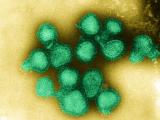May 29, 2008 (CIDRAP News) – With summer temperatures settling in across the United States, health authorities are conceding that the novel H1N1 flu virus may continue circulating through the summer, rather than quieting down as seasonal flu strains do.
That could pose major challenges for surveillance of the new flu's spread, because some important disease indicators, such as school absenteeism, cannot be used during the summer. It will also tug research on the strain toward an aspect of flu that is not well understood despite years of inquiry: why influenza is a seasonal infection.
The Centers for Disease Control and Prevention (CDC) signaled yesterday that it does not expect the novel virus to mimic seasonal flu's usual summer hiatus.
"There are some aspects of what we're seeing that are very different from seasonal patterns," Dr. Anne Schuchat, the CDC's interim deputy director for science and public health programs, said at the agency's Thursday press briefing. "This virus is circulating much later than the annual flu viruses. We're really not seeing much of any other seasonal flu viruses anymore. But we are continuing to see this strain circulate, even though of course we're almost at June."
Echo of pandemics past?
If the new flu does continue transmitting through the northern hemisphere summer at a high enough level to be noticed by physicians and hospitals, that would make its behavior less like common seasonal flu and more like the novel strains that have caused pandemics in the past, or been feared as a possible pandemic spark. The 1957 pandemic was seeded across the United States in June and July by children attending summer camps and the National Boy Scout Jamboree. The first recognized human cases of avian influenza H5N1, long thought to be a possible cause of the next pandemic, occurred in Hong Kong in August 1997.
In a paper published ahead of print May 27 in the New England Journal of Medicine, Marc Lipsitch, D Phil, of the Harvard School of Public Health and co-authors say that authorities should prepare for uninterrupted spread: "The Southern Hemisphere at least, and possibly the entire world, is likely to see a substantial epidemic of this virus in the next few months, with attack rates exceeding those in a typical influenza season."
They warned that continued transmission will pose a number of challenges. First, schools are about to close for the summer—so authorities will not be able to use school absenteeism, a frequently used indicator of disease spread, to measure the new flu's incidence. Add in that many health departments and hospitals have stopped testing presumed cases of novel H1N1, and that symptoms of the new flu resemble the symptoms of other flu strains and respiratory infections, and authorities could well face the autumn not knowing how many cases occurred over the summer.
That would mean that they might not be able to estimate H1N1's attack rate, or the percentage of cases that proceed to severe disease, two calculations that are key to future preparations but that require some estimate of incidence in order to be reliable.
The mystery of seasonality
Behind the uncertainty lies a knowledge gap. Despite decades of research, scientists are still not certain why seasonal flu is seasonal. That is, they do not know for sure why flu causes epidemics in the temperate zones' winters and not year-round—or why, in the tropics, flu is not seasonal and does cause disease year-round, but rarely causes epidemics.
Influenza's seasonality has been attributed to winter behaviors such as crowding into shared indoor air space; to winter climate changes, such as less sunlight to stimulate Vitamin D production, which boosts immunity; and to winter physiology, from cracked lips and noses that allow viruses into mucous membranes, to slow-moving bronchial cilia that fail to expel them from the lungs.
In a paper published in March, atmospheric scientist Jeffrey Shaman, PhD, of Oregon State University proposed that an important influence is absolute humidity, or the measure of how much water is present in the air regardless of the ambient temperature. "The environment strongly modulates how long the flu virus can remain viable in (an exhaled) water droplet once it is expelled from the body, and it is absolute humidity that is doing it," Shaman said in an interview. The lower the absolute humidity, the more likely flu viruses are to survive and spread—and in temperate regions, absolute humidity is lowest in winter.
Earlier studies, including experimental work on guinea pigs published in 2007, found more flu transmission in situations of low relative humidity, a separate measure of water content of air at particular temperatures. That is true in laboratory studies as well, said Walter Dowdle, PhD, the former director of the World Health Organization's Influenza Collaborating Center at the CDC.
"It always struck me that the virus is highly sensitive to high relative humidity," he said in an interview. "At 30% relative humidity and lower temperatures it will survive 3 and 4 days as an aerosol. But increase it to 75 degrees and 60% relative humidity and survivability drops down to about 8 hours."
But Dowdle cautioned that other factors—also not fully understood despite years of research—will affect how the novel H1N1 behaves during the summer as well as whether it burgeons, or merely perks along, when flu season begins again.
"The whole outcome of epidemics, their morbidity and mortality, are all multi-factorial," he said. "It involves the geography of spread, the health of the population. If the virus has an easier time transmitting because fewer people have resistance to it, then you can have circulation when you wouldn't have circulation of a so-called normal flu. It is just a matter of the ability of the virus to spread under whatever conditions the virus finds itself in."
See also:
Langmuir AD, Pizzi M, Trotter WY, et al. Asian influenza surveillance. Pub Health Rep 1958 February;73(2):114–20 [Full text]
Lipsitch M, Riley S, Cauchemez S, et al. Managing and reducing uncertainty in an emerging influenza pandemic. N Engl J Med 2009 May 27 (early online publication) [Full text]
Shaman J, Kohn M. Absolute humidity modulates influenza survival, transmission, and seasonality. Proc Natl Acad Sci 2009 Mar 3;106(9):3243-8 [Abstract]



















